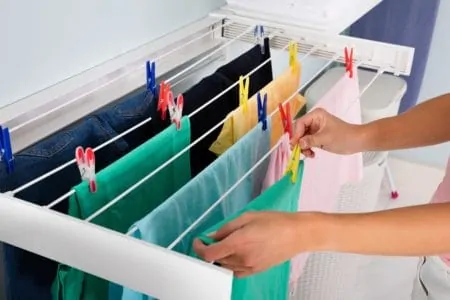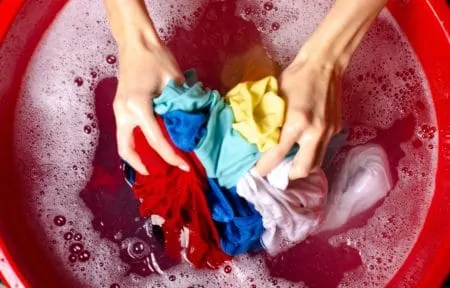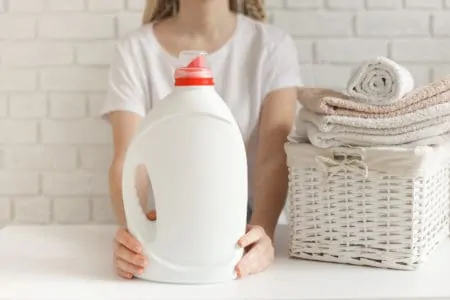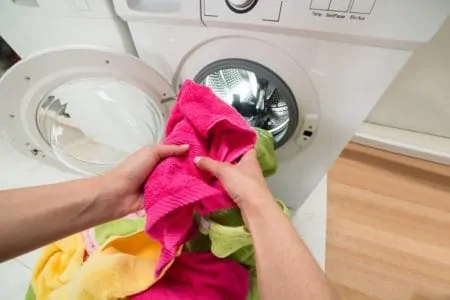No matter what clothes you’re drying, where you live, or what kind of weather it is — we’ve got the ultimate guide on how to dry clothing. Knowing how to properly dry clothes can save you time, stress, energy and even money.
If you’ve been wondering if there’s a better way to dry your clothes, you’ve come to the right place. Maybe we’ll even share some new nugget of information with you!
Key Takeaways
- Sort clothes by weight and material, and shake them before putting them in the dryer.
- Don’t overload the dryer, and add extras like dryer sheets or wool dryer balls.
- Choose the correct drying setting based on the fabric type, and follow care label instructions.
- Remove clothes immediately after drying and fold or hang them to prevent wrinkles.
- How to Dry Clothing in the Dryer
- How to Dry Clothing Without a Tumble Dryer
- How to Air Dry Clothes
- How Can I Make My Clothes Dry Faster?
- How Can I Dry Wet Jeans Fast?
- How to Dry Hand Washed Clothes
- Is It Bad to Dry Clothes in Your Bedroom?
- What Is the Best Way to Dry Clothes Indoors?
- How Can I Dry My Clothes Indoors Without Smelling Damp?
- FAQs
- Dry as a Bone
How to Dry Clothing in the Dryer
If you’re new to the world of tumble drying, or just want to check if you’re doing it right — follow these useful tips. A tumble dryer is an especially good machine to have during the winter months when it’s too cold to air dry your clothes well.
Caution
1. Sort Your Clothes
Before you toss things into the dryer, sort out your clothes. Different clothes require a different drying setting, so make sure to separate them.
For example, dry together clothes that can handle a higher heat, and dry together clothes that require a low heat. You can do this before washing your clothes for a more seamless washing routine.
2. Prep the Clothes
Once the clothes have been washed, check to make sure all stains or dirt is removed. Putting stained clothes in the hot dryer can set stains.
After you’ve checked for stains, shake out the clothes before putting them in the dryer. This reveals hidden items, like socks and underwear, and gets wrinkles out, too.
3. Don’t Overload
Overloading the dryer can slow down your drying time. There isn’t enough room for the clothes to move around and dry evenly. We recommend filling your dryer up about halfway, or 75 percent, maximum.
Your tumble dryer will also have a maximum wet weight. Do not exceed this weight or your clothes will not dry properly.
Dryer Tip
4. Add the Extras
If you’re putting anything inside your tumble dryer, now is the time. This could be a dryer sheet, wool dryer balls, a tennis ball or aluminum foil. All of these items will help clothes come out soft and wrinkle-free.
5. Choose the Right Setting
Depending on the type of clothes you’re drying, choose the correct drying setting. The care label on the garments will guide you here. Some fabrics require a low heat, while others can handle a higher heat.
In general, high heat works well for cotton and linen. Medium heat is good for synthetic fabrics. The gentle or low heat cycle is ideal for delicate items like lingerie and swimwear.
Some washing machines have an air dry cycle which is useful for fluffing up garments or refreshing clothes.
6. Remove the Clothes
Remove the clothes from the tumble dryer immediately to prevent more wrinkles. The clothes will set as they cool, so if they’re left in a crumpled up position for too long, they will set with wrinkles in them.
After you’ve removed them, fold them, hang them up or prepare them for ironing.
Is It Ok to Put Wet Clothes in the Dryer?
A dryer is intended to heat wet clothes until they’re dry, so yes, you can put wet clothes in the dryer. But it’s important to ensure the clothes aren’t sopping wet. If they are, put them on a spin cycle in the washing machine first to remove as much excess water as possible.
What Heat Should I Dry My Clothes On?
This depends on the care label instructions. In general, dryers have three main heat settings: high, medium and low.
For cotton and linen, use high heat. This shows up as three dots inside the dryer symbol on the care label. Use medium heat for synthetic items. This shows up as two dots on the care label.
Finally, for delicate items, use low. This shows up as one dot on the care label.
Does Drying on Low Heat Shrink Clothes?
It’s unlikely that low heat will shrink clothes. However, always check the care label as some garments should be air-dried only. This is usually because any type of heat might shrink or damage the clothes.
What Happens If You Dry Clothes on High Heat?
If the care label approves a high heat cycle, the garment should withstand this. Your garment should come out the other end looking as good as new! However, high heat may cause some garments to shrink, fade or — if there is glue or synthetic materials — melt.
Bonus Tip
Does the Dryer Kill Bacteria?
Putting clothes in the dryer at a high heat setting for 28 minutes can kill bacteria, germs and viruses (1). A handheld garment steamer is also a great way to kill bacteria. This works, especially on clothes that can’t handle a high heat drying cycle.
Why Do My Clothes Not Smell Fresh After Drying?
If your clothes still smell dirty or dank after drying, here are a few reasons why:
- You left them in the washing machine for too long before drying. Leaving clothes for more than an hour can cause them to cling to their damp smell. To fix the issue, you’ll need to wash the clothes again.
- You used too much or too little laundry detergent. If you use too much detergent, the machine can’t wash it all away. After your clothes are dry, you might notice a strange smell. Too little detergent might make it hard to get all the dirt from your clothes, and therefore, they’ll still smell.
- The dryer isn’t clean. You should clean your washing machine and dryer once a month.
- The machine was overloaded. This won’t fully dry your clothes, and therefore, they can have a damp musty smell.
- It’s taking too long to dry the clothes. If your machine is clogged, too full, or just not working properly, you might find you have to dry the clothes a few times to get them fully dry. The longer the clothes take to dry, the more likely they are to smell bad even once they’re fully dry.
How to Dry Clothing Without a Tumble Dryer
If you don’t have a tumble dryer, or just want to save some money and energy, we have lots of methods for you to try.
Using Towels
- Take the clothes from the machine and lay them, one garment at a time, on a clean white towel. We say white so you don’t risk color transfer from the towel onto the clothes.
- Next, roll the towel and garment tightly together, pressing gently as you go. This helps the towel to absorb excess water.
- If the garment needs to be dried flat (which is the case for heavy sweaters and delicate items), lay them on another dry clean white towel. This towel will absorb the excess moisture while the garment air dries.
High Spin
- Keep the clothes in the machine after the cycle is finished.
- Turn on the high spin setting. This removes excess moisture so they’ll air dry quicker.
This is a quick, convenient and energy effective way to prepare clothes for air drying.
Does a Spin Cycle Dry Clothes?
No. The clothes will still be damp, but they will not hold as much moisture as they did before the high spin cycle. The clothes will air dry quicker and be less likely to smell damp.
Using a Hair Dryer
- Hang the garment up.
- Set the hair dryer to a medium heat.
- Move the hair dryer across the garment holding it about six inches away from the garment. Don’t leave it over one section for too long as continued heat this high can damage the fabric.
- Turn the garment inside out to dry every inch of the garment.
- Continue until the garment is dry.
Caution
Using an Iron
Before starting, make sure the garment can be ironed. Check the care label for this information.
- Lay the garment flat on an ironing board or ironing blanket.
- Set the iron to a low temperature.
- Slowly iron over the damp garment.
- Flip the garment around and inside out to iron the entire piece of clothing.
- Put a clean white towel over the garment and crank up the heat to high.
- Iron over the garment again to zap out the remaining moisture.
Air Drying
Air drying is the most common way to dry clothes without a tumble dryer. You can air dry clothes inside or outside.
Outside is our preferred method as it’s quicker. The wind and air circulation dry the clothes quickly. However, you may not have an outdoor area, or perhaps the weather is snowy, rainy or humid. In these cases, air drying clothes inside is perfectly fine.
- Shake the clothes out after removing them from the wash. The smoother the garment, the easier it will be to dry.
- Turn bright or dark clothing inside out to prevent fading, especially if you’re hanging the clothes outside in the sun.
- If hanging outside, use a clothesline and clothespins to hang the garments. Make sure there is good airflow, and hang the clothes the correct way depending on the garment.
- If hanging clothes inside, use a drying rack and keep the clothes in a well-ventilated room with warm air. If the room is too cold, the clothes will take too long to dry. Space the clothes apart from each other to speed up drying times, and always ensure you hang the clothes appropriately according to the garment type.
- When the clothes are dry, fold or hang them. Iron if necessary.
Is It Ok to Air Dry Clothes?
Yes! Air drying clothes will save you money, energy, and it’s better for the environment. Air drying can also protect your clothes as the heat and agitation from the dryer can wear down the fabrics.
How to Air Dry Clothes
We’ll share some do’s and don’ts when it comes to air drying clothes. Following these tips will give you the best results when air drying.
How Can I Make My Clothes Dry Faster?
Nobody likes waiting around for laundry to dry. To speed up the process, here are our top tips:
- Do an extra high spin cycle before air drying or tumble drying your clothes.
- Add a dry towel to the first 30 minutes of your tumble drying cycle. This absorbs excess water and speeds up the drying time.
- Toss a tennis ball into the drying cycle. This encourages the clothes to bounce around more, which increases the drying time.
- Don’t overstuff the dryer. Clothes need the space to move around and dry, and if you overstuff, they won’t have this opportunity.
- Use a clothes wringer. These handy devices squeeze all excess water out of your clothes so you can air dry them quicker.
- Roll them up in a towel before air drying to remove excess moisture.
How Can I Dry Wet Jeans Fast?
The hairdryer tip is a good one for drying jeans! If you don’t have tons of time, prep them for air drying by doing the hairdryer tip for a few minutes. Then hang them outside on a warm windy day.
We also recommend the high spin cycle before air drying the jeans.
You could also toss them into the tumble dryer for 15 minutes on the low heat setting. This should zap out some of the excess moisture which will shorten the air drying time.
How to Dry Hand Washed Clothes
Hand washing clothes is a great way to save energy. However, the clothes will often be more wet than if they’ve just come out of the washing machine. If they can handle it, put them on the high spin cycle to drain excess moisture before air drying.
Otherwise, use a clean white towel to press out excess water. If the garment isn’t too delicate, use a hand wringer to squeeze out excess water most effectively.
Never twist wring garments as this can stretch the fabric. You can definitely press the garment against the side of a tub to drain excess moisture.
Is It Bad to Dry Clothes in Your Bedroom?
We recommend drying your clothes in a well-ventilated room, but to avoid bedrooms and living areas. Air drying clothes indoors can raise moisture levels by up to 30 percent (3).
This can increase the chances of mold growing indoors. If you have asthma or allergies, this can trigger a reaction.
Drying clothes outdoors is always the safest option.
What Is the Best Way to Dry Clothes Indoors?
Although air drying clothes outdoors is the best way, it’s not always possible, especially during the winter time.
Here are our top tips for drying clothes indoors:
- Hang the clothes up in a well-ventilated area. Opening windows and turning on fans can help.
- Hang the larger items at the top of a drying rack and the smaller ones at the bottom.
- Don’t hang clothes on the radiator as this can damage the clothing and increase the chances of mold.
- Avoid hanging the clothing in your bedroom or living area.
- Wash clothes overnight or in the morning so they have all day to air dry.
- Use coat hangers to dry your clothes. This keeps clothes in a good shape and also allows optimal air flow through the fabric.
- Invest in a dehumidifier which will deal with high moisture levels and also speed up the drying time.
How Can I Dry My Clothes Indoors Without Smelling Damp?
The damp smell is normal in the first few hours while the clothes are drying. But if the smell persists, it’s due to the clothes not drying fast enough. Following all our advice, tips and guidance can tackle the unpleasant damp smell. But as an extra measure, here are the top tips reiterated:
- Hang the clothes to dry as soon as the washing cycle has finished. They’ll still be smelling fresh from the cycle. If you leave them for too long before hanging, they will smell damp inside.
- Keep the windows open and the fans on to increase air flow.
- Spray some scented white vinegar onto the clothes as they’re drying to zap out bad smells.
- Don’t overlap the clothes as they’re drying. This slows down the drying time.
FAQs
Dry as a Bone
To make sure your clothes are bone dry, follow our top tips. Whether you’re air drying or tumble drying, this guidance will help you protect your clothes while ensuring they’re super dry.
Our tips will also decrease your chances of mold indoors and damp smelling clothes. Now, no matter the weather or time of year, you can have fresh, clean and dry clothes!














